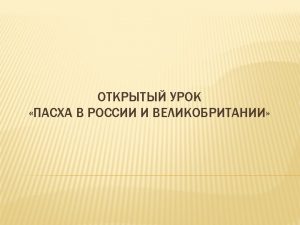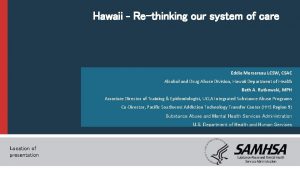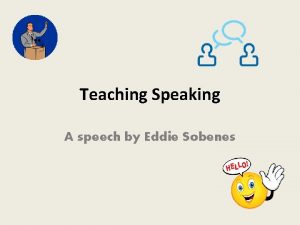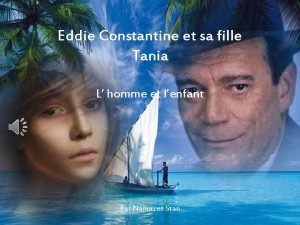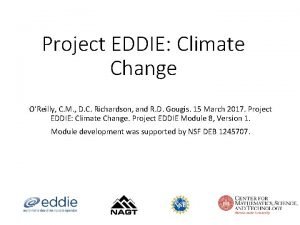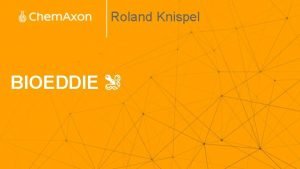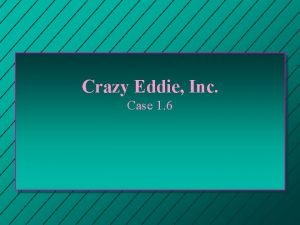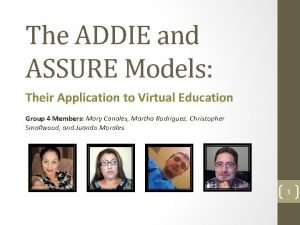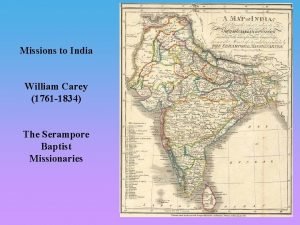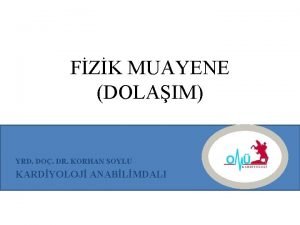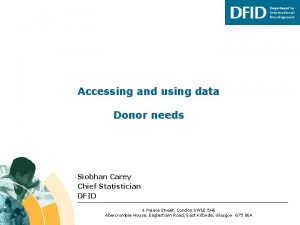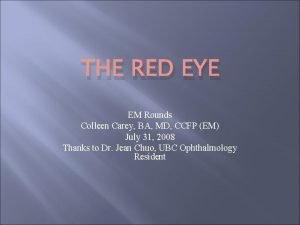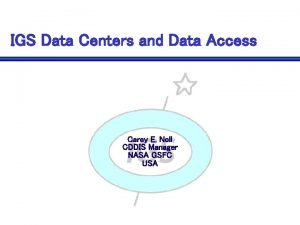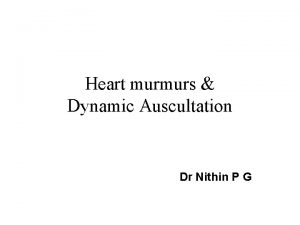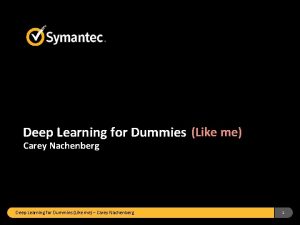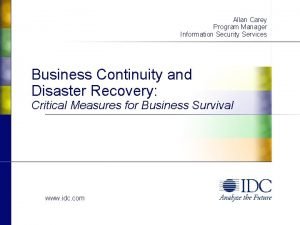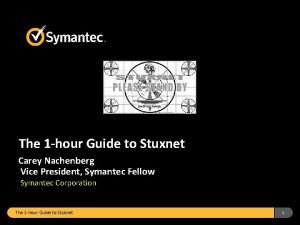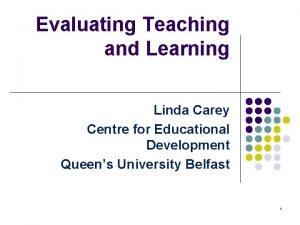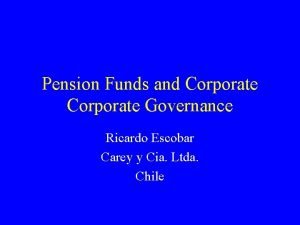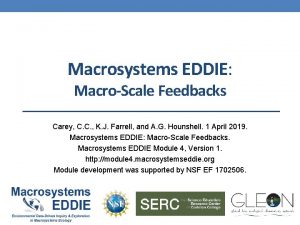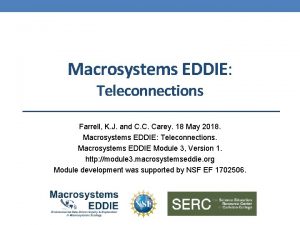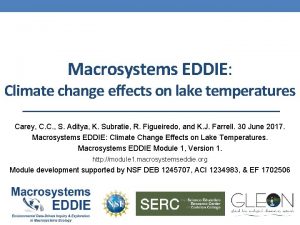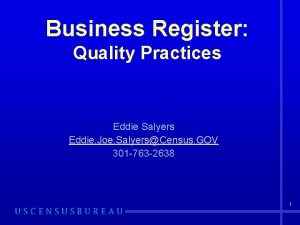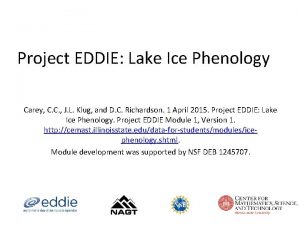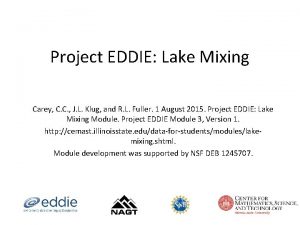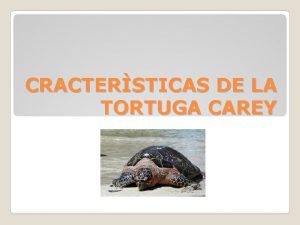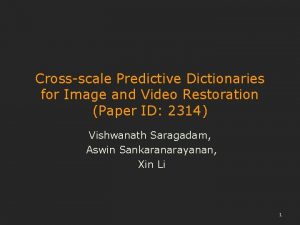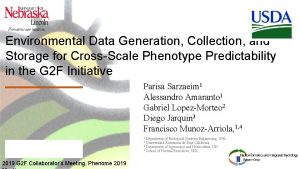Macrosystems EDDIE CrossScale Interactions Carey C C and












































- Slides: 44

Macrosystems EDDIE: Cross-Scale Interactions Carey, C. C. and K. J. Farrell. 13 August 2017. Macrosystems EDDIE: Cross-Scale Interactions. Macrosystems EDDIE Module 2, Version 2. http: //module 2. macrosystemseddie. org Module development was supported by NSF EF 1702506.

Plan for today: § Short overview on changing water quality in lakes globally, and how we can use a macrosystems ecology and lake modeling approach to study this problem! § Activity A: Run and explore a lake water quality model in R. § Activity B: Select a climate scenario, generate hypotheses, and model how different lakes respond. § Activity C: Model the effects of climate and land use change scenarios on different lakes, and make predictions about drivers of phytoplankton blooms at large spatial scales. Nara Souza, Florida Fish and Wildlife Commission

Phytoplankton blooms increasing globally § Blooms occur when phytoplankton populations rapidly increase § Result in turbid water, surface scums § Pose a major water quality threat to drinking water § Many bloom-forming species produce toxins NASA Visible Earth harmful to humans and other animals § Bacteria decomposing dead phytoplankton consume large quantities of oxygen § “Dead zones” of low oxygen & fish kills NOAA

What are the drivers of these blooms? § Land use change § Changing forest into agricultural fields or urban areas increases the amount of phosphorus (P) flowing into lakes § Phosphorus stimulates phytoplankton growth § Warming climate § Many phytoplankton species thrive in warmer waters Image modified from: Lake Champlain Basin Program (sol. lcbp. org)

Using a macrosystems ecology approach to study phytoplankton blooms § Drivers of blooms occur at both local and regional scales § Local = e. g. , land use § Regional = e. g. , climate change § Macrosystems ecologists study ecological dynamics and feedbacks at multiple interacting spatial and temporal scales § We can study local and regional drivers using high frequency sensor data + simulation models Figure modified from: Heffernan et al. 2014

Cross-scale interactions: What are non-linear responses? § Cross-scale interaction: processes at one scale interact with processes at another scale, which can sometimes create non-linear responses § Non-linear responses occur when the change of an output is not proportional to the change of the input § Responses may appear unpredictable or counterintuitive Figure modified from: Heffernan et al. 2014

Cross-scale interactions: Example § A non-ecological cross-scale interaction could occur when trying to predict a farmer's income for a particular year. § Local weather affects how well crops will grow § Global demand for crops affect market prices § These two factors operate on very different scales, and interact to affect a farmer's income § It would be very difficult to predict the interactive effects of local & global factors on farmer income by looking at them in isolation +

Cross-scale interactions in lakes § Phytoplankton blooms exhibit cross-scale responses to regional warming climate and locally-increasing lake nutrients due to land use change § Bloom severity and timing can be difficult to predict due to cross-scale responses to climate + land use C. C. Carey § Moreover, cross-scale interactions prevent us from predicting whether an algal bloom will occur in a particular lake by looking at climate change or land use change alone C. C. Carey

Our focal question: How will changes in land use and climate interact at local and regional scales to affect lake water quality, specifically, the timing and intensity of phytoplankton blooms? Image: K. J. Farrell

Models to understand multiple drivers § How can we test the effects of drivers from different spatial scales on lake phytoplankton blooms? § Impossible to experimentally manipulate all possible climate and land use drivers in a real lake! § Simulation modeling allows us to explore what would happen if we changed one driver, or multiple drivers at once: § For example, how would phytoplankton bloom severity change if air temperatures were 2°C warmer than they are now? 4°C? 6°C? § What if phosphorus inputs to the lake increased or decreased? +2°C +4°C +6°C

GLM: General Lake Model § Authors: Matt Hipsey, Louise Bruce, and David Hamilton § The General Lake Model (GLM) is an open-access model for simulating lake dynamics. It simulates vertical stratification and mixing and accounts for the effect of inflows/outflows, surface heating and cooling. § GLM has been designed to be an open-source community model developed in collaboration with members of the Global Lake Ecological Observatory Network (GLEON) to integrate with lake sensor data. § Available from: http: //aed. see. uwa. edu. au/research/models/GLM/

Figure: Hipsey et al. 2014

AED: Aquatic Eco. Dynamics § The Aquatic Eco. Dynamics (AED) module couples with GLM to model changes in water chemistry and biology § Can model nutrient, phytoplankton, and zooplankton dynamics § Today, we’ll focus on phytoplankton (as chlorophyll-a) Figure: Hipsey et al. 2013

Basic structure of the model § You’ll create a new folder (directory) on your computer when you unzip the module folder. § Within this folder, you will have: 1) 2) 3) A meteorological CSV (‘met’) file that forces the model (e. g. , met_hourly. csv) ‘nml’ text files that act as ‘master’ scripts for the model (e. g. , glm 2. nml, aed 2. nml) Inflow/outflow CSV files that specify the temperature, flow rate, and concentrations of phosphorus of connected streams entering and leaving the lake Images: Wikimedia commons

Example met file Climate scenarios: +2°C, +4°C, or +6°C

Example. nml file

Example inflow file Land use scenarios: 2×, 4×, or 6× P Nitrogen Phosphorus PHS_frp = the type of phosphorus that phytoplankton take up. High concentrations can promote blooms

We will run GLM-AED using R § R is a statistical environment that can run on different computer operating systems (PC, Mac, Linux) § R is reproducible, free(!), and easy to download § R can run stats, make figures, and do a suite of different analyses in many disciplines § Many packages for R to merge with other tools (including GLM!) § We’ll walk you through each step of the script, so don’t worry if you’re new to R!

Lakes we’re going to model today Lake Sunapee Lake Mendota (New Hampshire, USA) (Wisconsin, USA) § Oligotrophic § Eutrophic § Low nitrogen § High nitrogen § Low phosphorus § High phosphorus § Main land uses: § 81% Forest § 55% Agriculture § 8% Urban § 20% Urban § 4% Agriculture § 1% Forest GLEON. org engr. wisc. edu

Learning objectives § Understand the concepts of macrosystems ecology and cross-scale interactions, and how different ecological processes can interact at local, regional, and continental scales. § Simulate phytoplankton blooms in multiple lakes using ecosystem models of lake water quality set up with publicly-available high-frequency sensor datasets (Activity A). § Test the effects of a climate scenario on the different lake models, and examine how the timing and intensity of phytoplankton blooms change with climate warming (Activity B). § Examine the effects of both local nutrient loading and regional climate forcing to determine how factors acting at different scales interact to affect the intensity and timing of phytoplankton blooms (Activity C). § Predict how lake phytoplankton blooms may respond globally to changing climate and land use.

Workflow of module § We'll be using pre-made climate and land use scenarios based on real predictions for these lakes +2°C, +4°C, or +6°C 2×, 4×, or 6× P

Discussion questions embedded in your handout § Everyone will need to turn in the completed handout with question answers written out at the end of the module today. § We encourage you to work with your partner to complete the questions! Image: newsfrom 4 j. wikispaces. com

A few important notes about R • Lines of code that start with # are not read by R • These lines include important notes about how and why the R script is running, so be sure you’re reading them! • Lines with ##!! indicate lines of code where you need to modify something for it to run • In the glm 2. nml file, ! indicates lines that are not read by the GLM model (tricky!) • When you need to modify your glm 2. nml file in Activity B, make sure you’re not changing the value in a line that starts with a ! or your changes won’t be read by GLM

Activity A: Run a lake model! With a partner (work in pairs): 1) Find the two lakes on a satellite map, and examine land use in their watershed 2) Coordinate with another pair of students so that each pair is modeling a different lake 3) Download the zipped folder of R scripts and other files to run this module. Extract to your desktop 4) Download GLM-AED files and R packages onto your computer 5) Run the model and look at the output for temperature and chlorophyll-a for your lake (make sure you save your plots as you go!)

Activity B: Climate change scenario 1) Working with the other pair of students, select one of the pre-made climate change scenarios for air temperature. Develop hypotheses about how changing air temperatures may affect water temperatures and chlorophyll-a in your model lakes 2) Modify your glm 2. nml file to test your hypothesis § Run both model lakes with the same scenario § Analyze the model output to determine how the scenario changed water temperature and chlorophyll-a 3) Create a few figures (save them as you go!) to examine your climate scenario: § Does the model output support or contradict your hypothesis? § How does the output from the two lakes compare? § Which lake’s phytoplankton are more sensitive to the climate scenario? How can you tell?

Activity C: Climate and land use change 1) 2) 3) Working with the other pair of students, select one land use scenario for phosphorus inputs. Make hypotheses about how land use change will affect phytoplankton blooms. Modify the glm 2. nml file, then run the model. Now modify your glm 2. nml file to change temperature and phosphorus simultaneously. Run the additional scenario for both lakes. You will now have 4 scenarios (no change, climate change only, land use only, and land use + climate change) for each lake. Create a few figures (save them as you go!) to highlight your 4 scenarios & share with the class! § Does the model output support or contradict your hypotheses? § How does the output from the two lakes compare? § Are the phytoplankton in your lake more sensitive to climate change, land use change, or both? How does this compare among different lakes? § Do your lakes show evidence of cross-scale interactions? Why or why not? 4) Predict how lake phytoplankton blooms may respond to changing climate globally, given different land uses.

Evidence for Cross-Scale Interactions? § Phytoplankton blooms are driven by processes occurring at different scales: § Increasing lake nutrients (local) § Warming climate (regional) § In your lake, did you observe cross-scale interactions in phytoplankton bloom timing and/or intensity? § Climate had an effect § Land use had an effect NOAA

Do we see individual effects of climate and/or land use? Mendota Scenario Sunapee Chlorophyll-a (ug/L) Difference from baseline Baseline 50 -- Climate only 41 - 9 Land use only 70 + 20

Evidence for Cross-Scale Interactions? § Phytoplankton blooms are driven by processes occurring at different scales: § Increasing lake nutrients (local) § Warming climate (regional) § In your lake, did you observe cross-scale interactions in phytoplankton bloom timing and/or intensity? § Climate had an effect § Land use had an effect § Climate + land use had interacting effects NOAA

Do we see interacting effects of climate + land use? Mendota Scenario Sunapee Chlorophyll-a (ug/L) Difference from baseline Baseline 50 -- Climate only 41 - Land use only 70 + 20 Climate + Land use 55 + 9 5

Evidence for Cross-Scale Interactions? § Phytoplankton blooms are driven by processes occurring at different scales: § Increasing lake nutrients (local) § Warming climate (regional) § In your lake, did you observe cross-scale interactions in phytoplankton bloom timing and/or intensity? § Climate had an effect § Land use had an effect § Climate + land use had interacting effects § Were these effects linear or non-linear? NOAA

Are interacting effects of climate + land use linear or non-linear? Mendota Scenario Sunapee Chlorophyll-a (ug/L) Difference from baseline Baseline 50 -- Climate only 41 - Land use only 70 + 20 Climate + Land use 55 + 9 5 + 11

Evidence for Cross-Scale Interactions? § Phytoplankton blooms are driven by processes occurring at different scales: § Increasing lake nutrients (local) § Warming climate (regional) § In your lake, did you observe cross-scale interactions in phytoplankton bloom timing and/or intensity? § Climate had an effect § Land use had an effect § Climate + land use had interacting effects § Were these effects linear or non-linear? § How would your understanding of phytoplankton blooms be different if you had looked at just climate or land use changes in isolation? NOAA

Thank you for participating!

Optional additional slides § Depending on your class and the time available, you may want to include some of the following slides for discussion of the module concepts

Lakes we’re going to model today Maps: LAke multi-scaled Ge. OSpatial and temporal database (lagoslakes. org)

What are the possible cross-scale interactions between climate and land use? Additive effects of Chlorophyll-a (µg/L) climate and land use change (a linear CSI) 10 9 8 7 6 5 4 3 2 1 0 Climate Land Use Model Scenario Climate & Land Use

What are the possible cross-scale interactions between climate and land use?

What are the possible cross-scale interactions between climate and land use? Synergistic effects of climate and land Chlorophyll-a (µg/L) use change (a non-linear CSI) 20 18 16 14 12 10 8 6 4 2 0 Climate Land Use Model Scenario Climate & Land Use

What are the possible cross-scale interactions between climate and land use?

What are the possible cross-scale interactions between climate and land use? Antagonistic effects of climate and land use change (a non-linear CSI) Chlorophyll-a (µg/L) 6 5 4 3 2 1 0 Climate Land Use Model Scenario Climate & Land Use

What are the possible cross-scale interactions between climate and land use?

What are the possible mechanisms underlying these patterns? § Additive effects could happen when a lake is much more sensitive to one driver than another (linear CSI) § e. g. , an already-warm lake with low nutrients is likely more sensitive to land use than climate change § Synergistic effects could happen when a lake is equally sensitive to both factors, so increasing P and temperature simultaneously could trigger non-linear increases in blooms § Antagonistic effects could happen when a lake is not sensitive to either factor, so the two factors cancel each other out nonlinearly § e. g. , adding more nutrients and increased temperatures to an already- warm lake with high nutrients may inhibit phytoplankton growth if optimal thermal and nutrient conditions are exceeded

Thank you for participating!
 Guilherme carey ou william carey
Guilherme carey ou william carey Eddie and henry language paper 2
Eddie and henry language paper 2 Dick carey
Dick carey Dick & carey
Dick & carey Accounting information system chapter 1
Accounting information system chapter 1 Each easter eddie eats
Each easter eddie eats Dxing decoder
Dxing decoder Eddie mersereau
Eddie mersereau Eddie sobenes
Eddie sobenes L'oiseau bleu eddie constantine
L'oiseau bleu eddie constantine Eddie offord
Eddie offord L'oiseau bleu
L'oiseau bleu The falling man saigon execution
The falling man saigon execution Ethics photojournalism
Ethics photojournalism How global warming works
How global warming works Eddie rosen brian rosen
Eddie rosen brian rosen Eddie js
Eddie js Eddie adams arc flash
Eddie adams arc flash Eddie mabo grave vandalised
Eddie mabo grave vandalised Eddie tsai
Eddie tsai Trace vs vouch
Trace vs vouch Addie and assure model
Addie and assure model Fritz haarmann childhood
Fritz haarmann childhood William carey india
William carey india Ms carey ap psych
Ms carey ap psych Carey coombs üfürümü
Carey coombs üfürümü Addie model example lesson plan
Addie model example lesson plan Siobhan carey
Siobhan carey Ciliary injections
Ciliary injections Lou carey
Lou carey Ssssdddd.yt rinex file format
Ssssdddd.yt rinex file format Carey compass
Carey compass Carey vs musladin
Carey vs musladin Carey brothers logistics
Carey brothers logistics Conduction vs radiation of murmur
Conduction vs radiation of murmur Engblom vs. carey
Engblom vs. carey Carey nachenberg slides
Carey nachenberg slides Face shape step by step
Face shape step by step Allan carey
Allan carey Carey schwartz
Carey schwartz Carey nachenberg slides
Carey nachenberg slides Class ground rules
Class ground rules Carey y cia
Carey y cia Carey coombs üfürümü
Carey coombs üfürümü Qualities behaviors and complexities
Qualities behaviors and complexities





